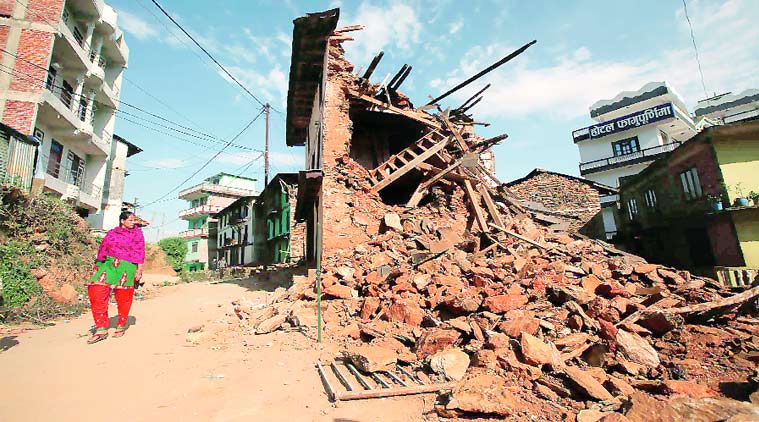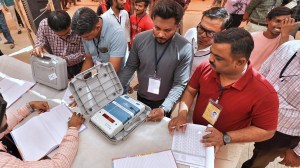- India
- International
Nepal earthquake: Homes to rebuild, illness to treat, fears to overcome
Earthquakes on April 25 and May 12, killed at least 8,622 people and damaged 756,000 houses and other buildings in Nepal.
 A collapsed house at Charikot in Nepal.(express Photo by: Tashi Tobgyal)
A collapsed house at Charikot in Nepal.(express Photo by: Tashi Tobgyal)
The two massive earthquakes that struck Nepal less than three weeks apart, killing over 8,500 people and bringing down thousands of homes, has left the country with a huge rebuilding task that includes fresh houses, long-term treatment of illnesses and many fears to overcome.
House by house
With the monsoon approaching and thousands still living outside, the Nepal Engineers Association (NEA) has begun surveying homes in affected areas and classifying them as safe, in need of repairs, or hazardous. “We first began from three districts in Kathmandu Valley — Kathmandu, Lalitpur and Bhaktapur — and then expanded outwards. In Kathmandu, of the 30,900 homes surveyed so far, 20 per cent have been classified ‘hazardous’ and have to be demolished while 29 per cent need repair before being fit to live in,” said NEA general secretary Kishore K Jha. While carrying out their assessments, the NEA — about 60 teams with at least 5 engineers each — used guidelines framed with help from the UNDP. “We have been assigning stickers for buildings. ‘Red’ if they need to be demolished, ‘yellow’ if they need repairs and ‘green’ for structurally safe ones,” Jha said.
[related-post]
But there is still a lot of ground to cover. “What is at stake is that if a building is safe, and people are still living outside, they open themselves up to diseases and illnesses in the monsoon that will add to an already overwhelmed medical infrastructure. Conversely, if people continue to live in a house that is damaged, then they are in danger during the rains. Besides, to bring down a dangerous building, we need expertise from abroad because there is not enough know-how here. It is a massive challenge for us,” said a senior official of the Ministry of Urban Development.
Long treatment
With over 17,000 injured besides the dead, Nepal’s hospitals have been overwhelmed since April 25. Dr Deepak Prakash Mahre, director of the Tribhuvan University Hospital in Kathmandu, said many of the injured will require long-term treatment. “In an earthquake, the type of injuries you see, such as multiple compound fractures and spinal cord problems, often require revision surgeries. With medical infrastructure very poor in rural areas of Nepal, hospitals like ours in Kathmandu are under stress,” he says.
The monsoons will bring another challenge. “The problem is that with people living outside and with the impending monsoons, we could be flooded with cases of pneumonia and cholera. We are worried about snakebites during the rains,” said a doctor at Bir Hospital.

But the biggest danger that lurks, say doctors, is of “psychological trauma”. “People may have survived, but they have seen houses fall on loved ones… There are mass symptoms of acute stress disorder and post-traumatic stress disorder,” says Dr Mahre.
Nepal only has around 90 psychiatrists and 300 counsellors, a doctor at the National Trauma Centre said.
Fears inside and outside
One major challenge for various agencies has been to separate fact from fiction. For instance, NEA figures show 51 per cent of buildings in Kathmandu valley are safe, yet residents of those buildings still stay outside, increasing the load on district administrations. Kishore Jha of the NEA said the government must bring out advertisements “to “convince people” to go back to their homes if they are safe.
Outside, there is another fear. Close to eight lakh tourists visited Nepal in 2013, a number that is expected to go down by close to 50 per cent. The challenge now is to mitigate the loss.
Sarad Pradhan, officer with the Nepal Tourism Board, says, “Tourism right now brings in three per cent of the GDP but is a massive growth sector for Nepal. We have set up a Tourism Recovery Committee which has decided to repair the 581 heritage sites that were damaged in the earthquake. We are also working with the Pacific Asia Travel Association to give out the right message that Nepal is safe. Much of our tourism inflow was from travel to Everest but that has been damaged.”
Loan needed — and repayment
A massive financial challenge lies in wait for the country’s banks and other financial institutions. “With entire homes collapsing, insurance companies are facing a huge problem. Additionally, people will now find it difficult to repay debts to banks and instead require more loans to build homes,” said a senior official of Nepal Bank.
In a country where agriculture makes up 36 per cent of the GDP and 76 per cent of employment, rural areas suffered. Mohan Bahadur Tamang, a farmer in Deorali village in Sidhupalchowk, says that every crop season, he borrows from a moneylender, plants maize and other crops, and returns the money at the end of the sowing season. “I have done that for 20 years now. But now my house has come down and a good house will take several lakhs to build. The government has announced a loan to build houses, but I will have to repay the money. How will I pay the moneylender, and why will he give me anything when he knows I cannot pay?”
Ray of hope
From the crossroads, the future looks bleak, but there are many who are optimistic. In the building sector, for instance, experts now expect greater enforcement to the National Building Code. While the code itself is exhaustive on earthquake resistance, many hope that residents will now go for buildings that stick to the guidelines, despite the higher cost involved. Experts say that in rural areas, the need is to introduce the concept of cluster homes instead of inaccessible homes that are scattered in the mountains.
Apr 18: Latest News
- 01
- 02
- 03
- 04
- 05






































